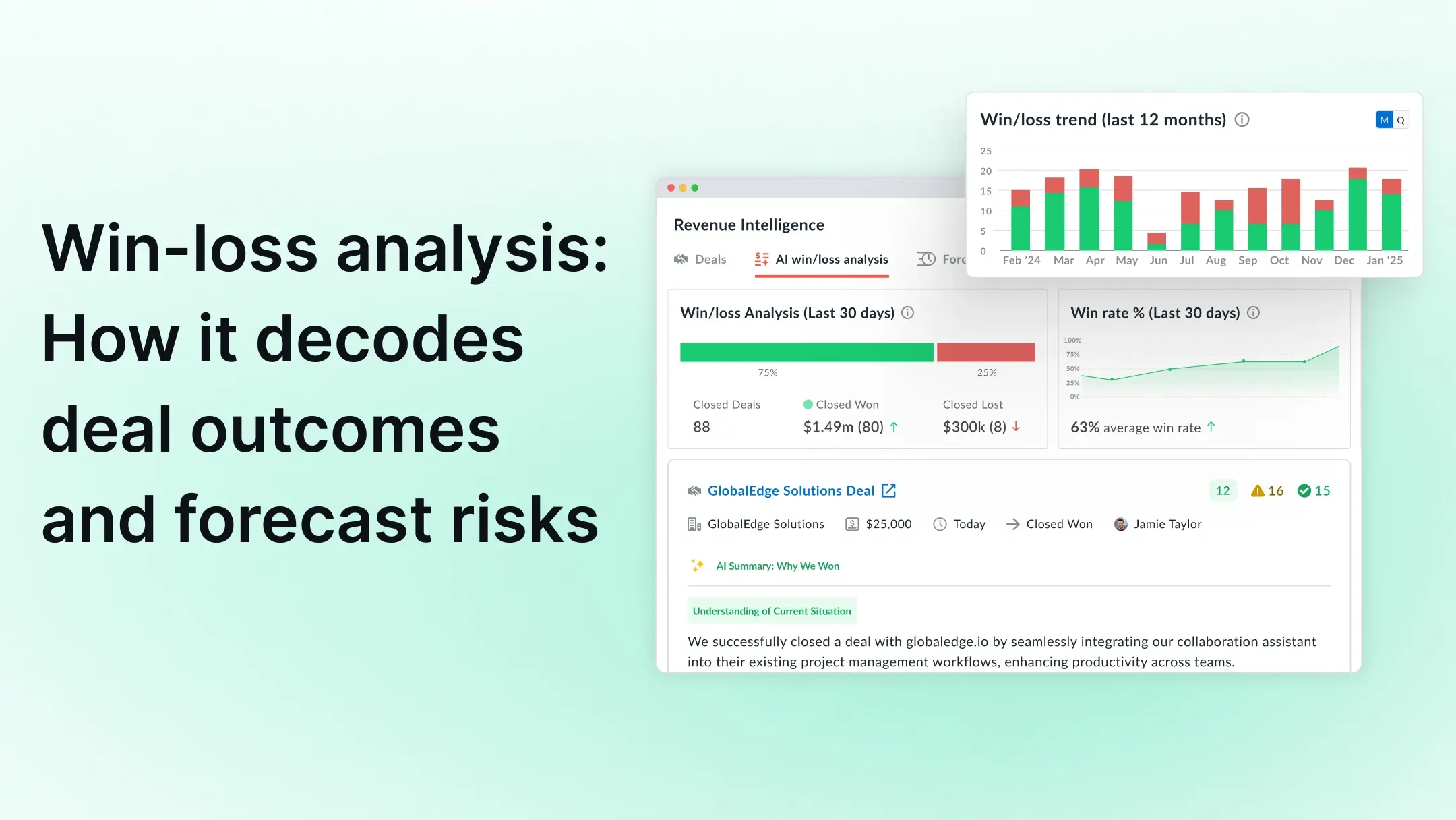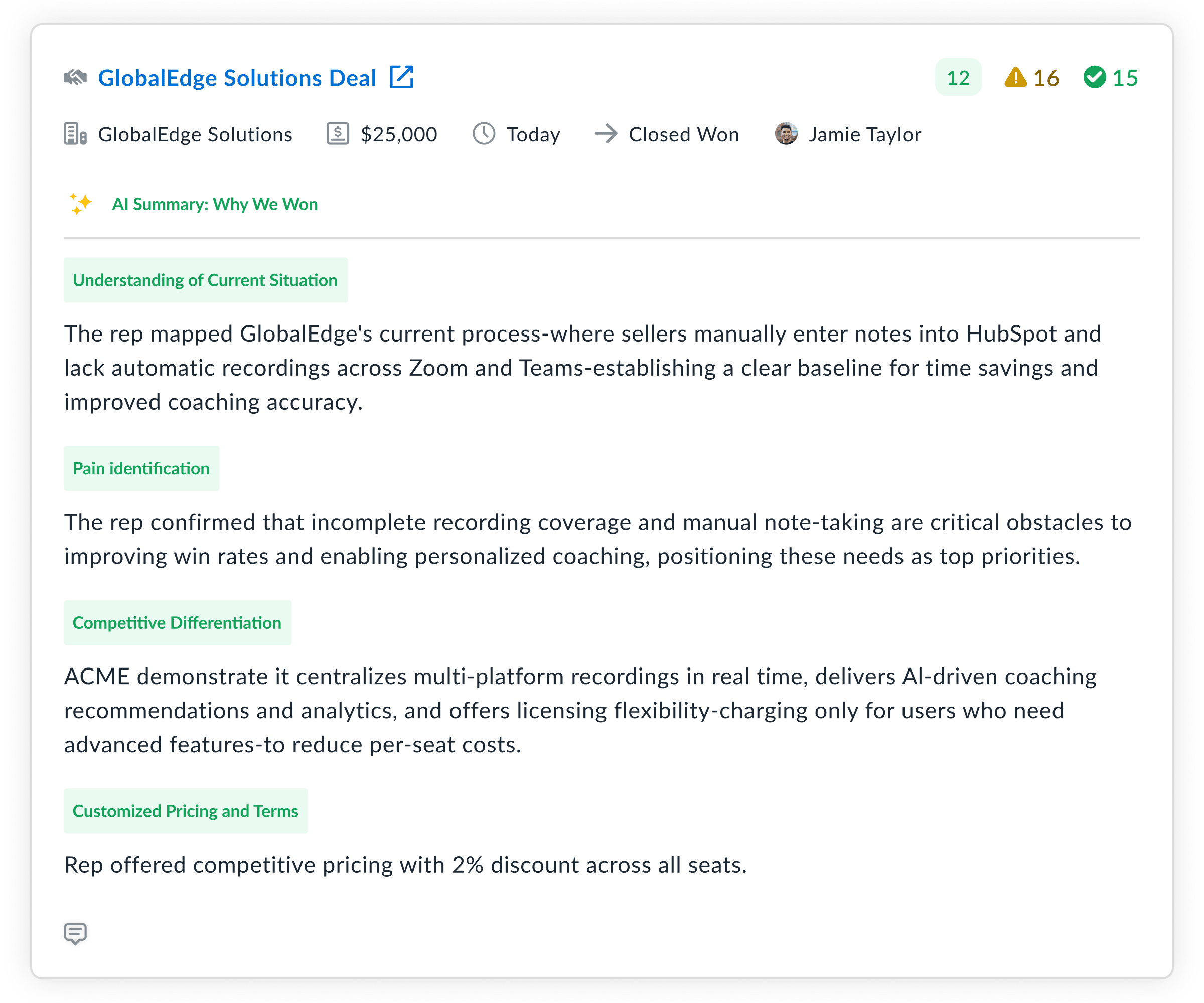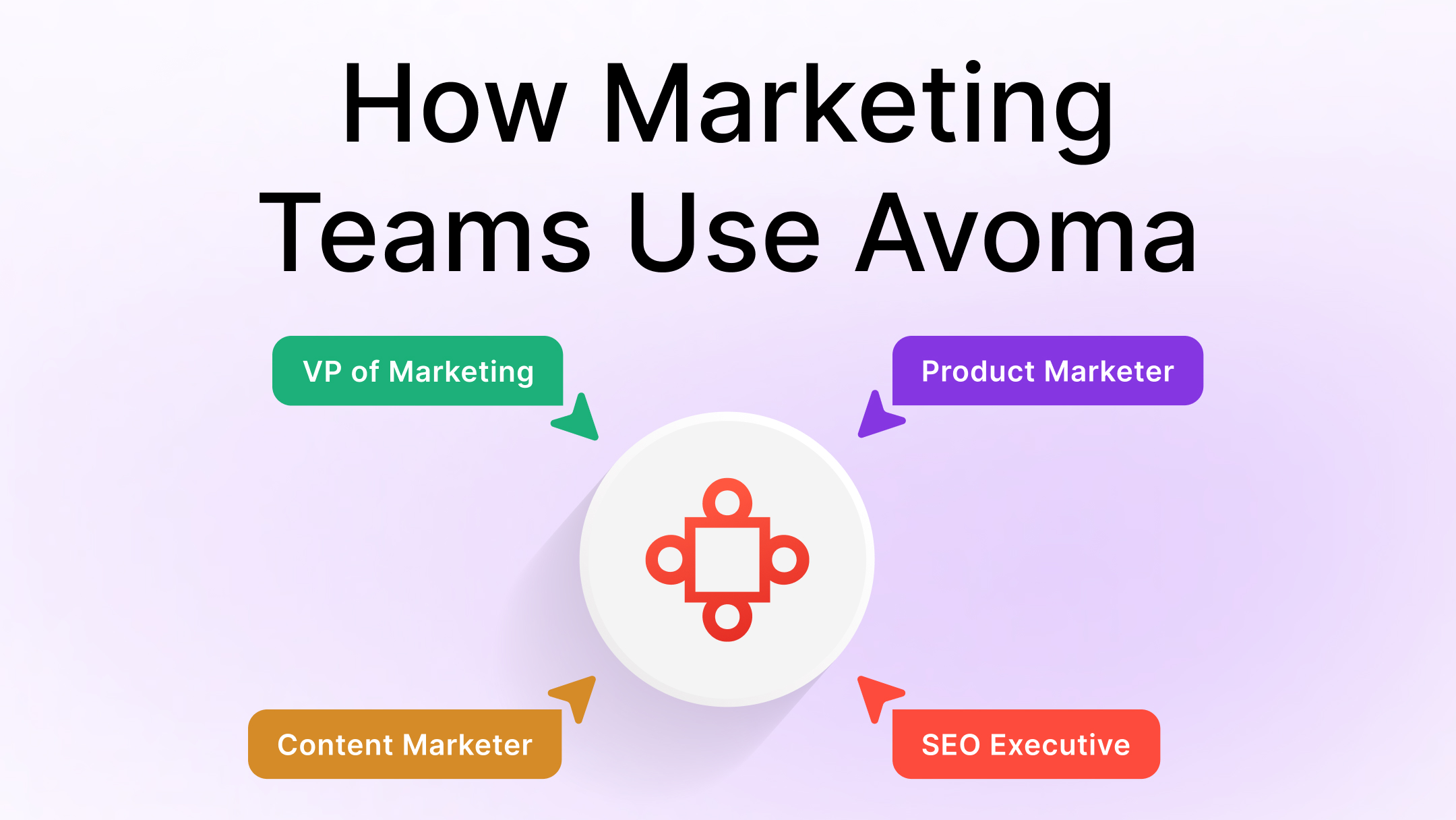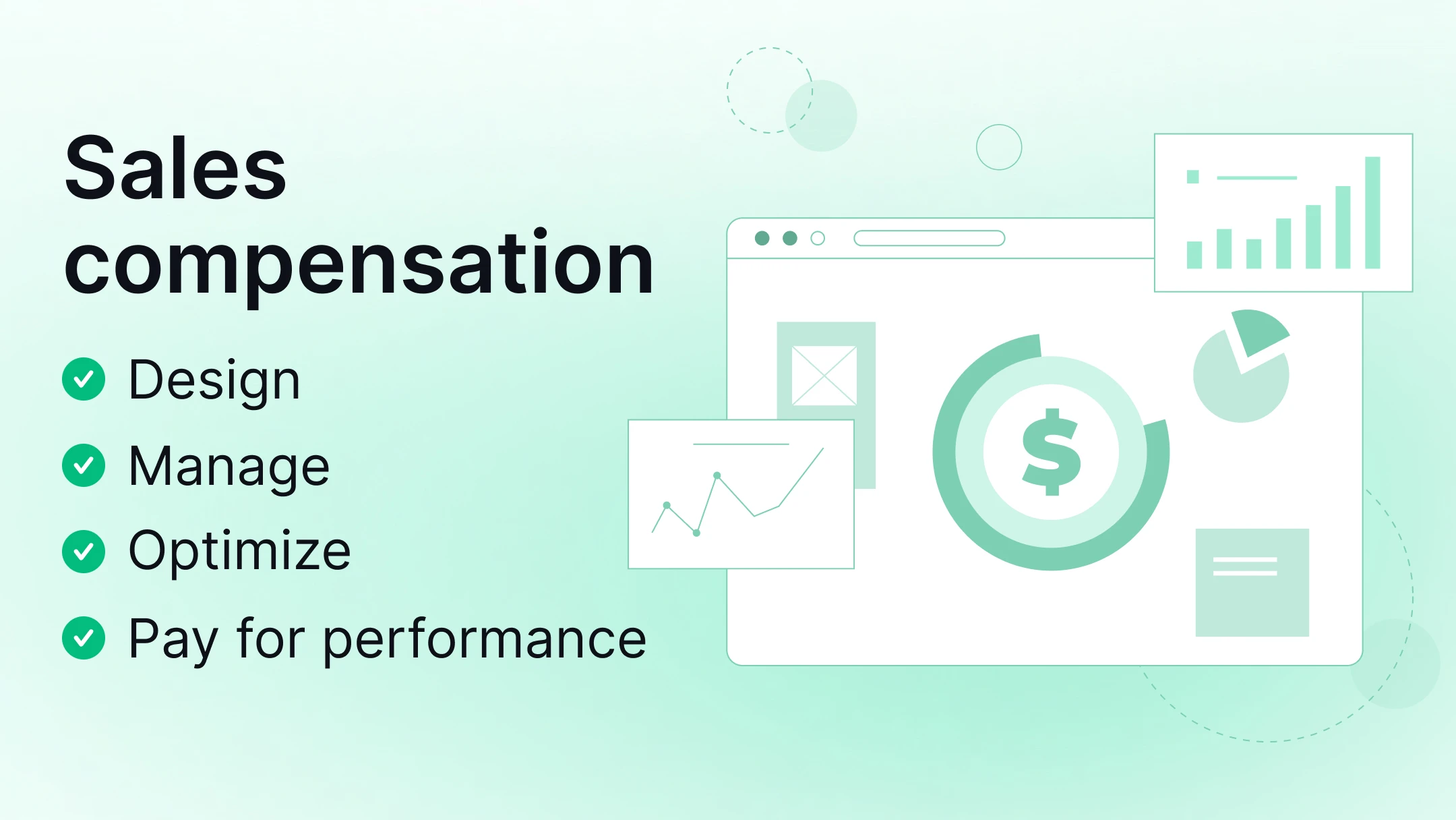Win-loss analysis: How it decodes deal outcomes and forecast risks
Table of Contents:

Win-loss analysis helps answer one of the most important questions in revenue execution: Why did we win or lose that deal?
Most revenue teams can’t confidently answer that. As your team scales, reviewing every sales interaction manually becomes impossible. Sales managers can't scale call reviews as fast as the team grows. At best, they manage to review 20–30% of conversations.
Even if you tried to review all calls (say your team has 5 AEs handling 5–6 deals each), you would spend over an hour a day just listening to calls, even at 2x speed. Since reviewing every interaction isn’t realistic, most teams fall back on rep-selected CRM fields like “lost to pricing” or “bad timing,” which are often placeholders, not explanations. Notes on won deals can be even more vague, such as “provided value.”
These surface-level inputs can’t explain what truly happened in the deal, when objections were raised, or how the buyer journey evolved. AI win-loss analysis solves this by reviewing customer interaction including calls, emails, and CRM activity. It offers structured insight into what drives deal outcomes.
This blog explains all you need to know about win-loss analysis and how it strengthens revenue intelligence.
TL;DR: Key takeaways
- Manual win-loss review is slow, biased, and only covers a fraction of deals
- AI-powered win-loss analysis reviews 100% of buyer interactions across calls, emails, and CRM data
- Sales, RevOps, and product teams use these insights to coach smarter, forecast better, and prioritize based on actual buyer feedback
- Organizations that systematize win-loss analysis improve win rates and go-to-market alignment
- Avoma offers win-loss analysis as a core feature within its all-in-one revenue intelligence platform
What is win-loss analysis?
Win-loss analysis is the process of examining why specific deals were won or lost. Customer surveys only capture feedback from those who convert. AI-powered win-loss analysis gives you a balanced view of the deal outcome. It helps you understand:
- What drove a customer to choose you
- Why a prospect picked a competitor or didn’t move forward
When done consistently and at scale, win-loss analysis becomes a powerful driver of continuous improvement across sales, RevOps, and product teams.

Why use AI win-loss analysis
Traditional sales win-loss analysis involves reviewing CRM records, interviewing reps, chasing down customer feedback, and manually comparing notes across deals. It’s a multi-step process that is time consuming and offers results that are often incomplete or biased.
Avoma’s win-loss analysis software moves past that by embedding the capability into its revenue intelligence platform. It captures insights from and pushes them into deal reviews and coaching, forecasting.
Here’s what makes it distinct:
- Automatic CRM updates: As soon as a deal is marked "Closed Won" or "Closed Lost," Avoma’s AI analyzes all related calls, emails, and meeting transcripts and writes back structured reasons into your CRM.
- Deal-level detail with context: For each closed deal, it offers “Why We Won / Why We Lost” AI summaries that highlight objection moments, feature gaps, delayed follow ups, or competitor mentions, grounded in actual conversations.
- Integration with pipeline and forecast workflows: The insights sync into dashboards, alerts, and deal review cycles without manual handoffs—so win-loss becomes part of your operational rhythm.

- Confidence scoring: Each insight includes signal strength indicators, so you know what’s most likely to have influenced the outcome.
By using these capabilities, Avoma ensures that your sales win-loss analysis is a continuously feeding feedback loop. It turns closed deals into actionable insight without extra effort from your team.
Traditional vs AI win loss analysis: What’s different?
Most win-loss programs still rely on manual analysis, CRM tags, or periodic interviews. These methods are slow, shallow, and only scratch the surface. AI-powered win-loss offers a more scalable, structured, and consistent way to extract insight from every deal.
An AI-powered win-loss analysis highlights:
- Which product gaps are causing deals to stall
- How buyers perceive your sales team's approach and follow-up
- Whether your messaging actually lands with different segments
- What priorities drive decisions for your target customers
- How your offering compares in real sales conversations
With this intelligence, sales teams can coach based on real themes, RevOps can detect deal risk sooner, and product teams learn about the feature gaps that impact conversion. It transforms win-loss analysis from a periodic, manual task into a continuous source of insight embedded in your workflows.
How to embed win-loss analysis into your GTM workflows
Win-loss insights are most valuable when they’re delivered in real time and integrated directly into how teams operate. Instead of living in static reports, these insights shape daily activities like deal reviews, coaching, and forecasting.
Here’s how different functions apply win-loss data in their core workflows:
- Deal reviews: Managers quickly see which objections came up and how reps responded—without replaying full calls.
- Pipeline reviews: Teams identify recurring loss patterns and apply those lessons to similar active deals.

- Forecasting: RevOps aligns qualitative buyer feedback with engagement signals to improve forecast accuracy.
- Coaching sessions: Sales leaders deliver targeted feedback based on themes across wins and losses.
- Roadmap planning: Product and marketing teams access real customer insights to understand feature gaps or messaging issues in lost deals.
Ready to unlock revenue insights with win-loss analysis?
Every closed deal holds a lesson that most teams miss. Without a scalable way to review what happened, revenue leaders are forced to rely on partial data, biased notes, or outdated assumptions.
Sales win-loss analysis closes that gap. By capturing 100% of conversations and turning them into structured insights, it helps your team move faster, coach better, and build go-to-market strategies grounded in what actually happens in the field.
Want to eliminate the guesswork and learn from every deal? Try Avoma’s win-loss analysis. Book a demo to see our platform in action.
Frequently Asked Questions
Win-loss ratio is the number of deals won divided by deals lost. Win rate is the percentage of total closed deals that were won. For example, winning 40 out of 100 deals gives you a 40% win rate and a 0.67 win-loss ratio. Both metrics help measure performance, but win rate is more commonly used in sales tracking.
Yes. AI detects patterns in buyer conversations—such as competitor mentions, objections, or preferences—that reveal why a rival may be winning. These insights support better positioning, objection handling, and targeted messaging against top competitors.
High-performing teams treat win-loss analysis as an ongoing process instead of a quarterly report. With AI, insights update continuously as deals close, keeping feedback loops active and helping teams adapt faster.
Modern AI tools like Avoma use conversation data and language models to surface insights with confidence indicators. Teams can validate these signals by reviewing transcripts or aligning them with known outcomes.
AI tools like Avoma detect objection patterns, competitor mentions, pricing concerns, feature gaps, timing issues, and buyer engagement across the deal cycle.
Yes. Avoma allows you to tailor win-loss categories and insights to align with your sales stages, messaging, and go-to-market motion






What's stopping you from turning every conversation into actionable insights?











